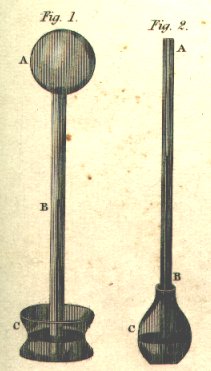Daniel Fahrenheit
Today, we invent the thermometer. The University of Houston's College of Engineering presents this series about the machines that make our civilization run, and the people whose ingenuity created them.
Daniel Fahrenheit, the man who put thermometry on a solid footing, was born in the Polish city of Gdansk in 1686. He was only fifteen when his parents both died from eating poisonous mushrooms. The city council put the four younger Fahrenheit children in foster homes. But they apprenticed Daniel to a merchant, who taught him bookkeeping and took him off to Amsterdam.
There he found out about thermometers. The Florentine thermometer had been invented in Italy some sixty years before. Now it showed up as a trade item in Amsterdam, and it caught young Fahrenheit's fancy. So he skipped out on his apprenticeship and borrowed against his inheritance to take up thermometer making.
When the city fathers of Gdansk found out, they arranged to have the 20-year-old Fahrenheit arrested and shipped off to the East India Company. So he had to dodge Dutch police until he became a legal adult at the age of 24. At first he'd simply been on the run; but he kept traveling -- through Denmark, Germany, Holland, Sweden, Poland. He studied and learned.
Ulrich Grigull, who tells Fahrenheit's story, points out that Florentine thermometer scales were quite arbitrary. No two were alike. Makers marked the low point on the scale during the coldest day in Florence that year. They marked the high point during the hottest day. Fahrenheit wanted thermometers to be reproducible. He realized the trick wasn't using the coldness or hotness of a particular day or place, but finding materials that changed at certain temperatures. Isaac Newton had had the same idea a few years earlier, but he wasn't a thermometer-maker. His idea stayed in books.
For seven years Fahrenheit worked out an alcohol thermometer scale based on three points. He chose the freezing point of a certain salt-water mixture for zero. He used the freezing point of water for 32 degrees. And body temperature he called 96 degrees.
Why the funny numbers? He originally used a twelve-point scale with zero, four, and twelve for those three benchmarks. Then he put eight gradations in each large division. That's how he got that strange 96 number -- it was eight times twelve. Body temperature is actually a tad higher than 96, but it was close. Later, Fahrenheit made mercury thermometers that let him use the boiling point of water instead of human body temperature for the high mark.
Fahrenheit was still only 28 when he startled the world by making a pair of thermometers that both gave the same readings. No one had ever done that before. The turning points of inventive genius are subtle. Fahrenheit made sense of temperature by seeing temperature scales in abstract terms. He realized, independently of Newton, that scales could be wed to universal material properties. But he also did what Newton failed to do. He built fine thermometers, and they carried his thinking into the world.
I'm John Lienhard, at the University of Houston, where we're interested in the way inventive minds work.
(Theme music)
Grigull, U., Fahrenheit, a Pioneer of Exact Thermometry. Heat Transfer, 1966, The Proceedings of the 8th International Heat Transfer Conference, San Francisco, 1966, Vol. 1, pp. 9-18.
Grigull, U., Newton's Temperature Scale and the Law of Cooling. Wärme und Stoffübertragung, 1984, Vol. 18, pp. 195-199.
This is a revised version of Episode 45.

On the Left, A Galileo Thermoscope (thermometer)
On the Right, A Florentine Thermometer
From the 1832 Edinburgh Encyclopaedia